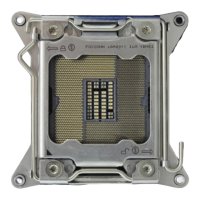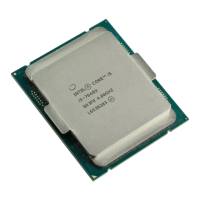Order Number: 334785-002 Intel
®
Xeon
®
Phi™ Processor x200 Product Family TMSDG
51
Thermal Specifications and Design Guidelines
6.2.3 Thermal Test Vehicle (TTV) Correction Factors
Intel offers thermal test vehicles to assist engineers developing and testing
thermal/mechanical solutions for LGA3647-1 socket-compatible systems. TTVs are
designed to mimic the thermal load of the actual die on the MCP under various work
usage scenarios. The TTV can be used for platforms with and without fabric by simply
turning the fabric die heater on or off.
Correction factors are provided for the processors to correlate the TTV heaters to the
si
licon die when analyzing heatsink characterization data.
T
Case_CPU_Product
= T
Case_CPU_TTV
+ CF
CPU
* (P
CPU
+ P
MCDRAM
+ P
Fabric
)
T
Case_MCDRAM_Product
= T
Case_MCDRAM_TTV
+ CF
MCDRAM
* (P
CPU
+ P
MCDRAM
+ P
Fabric
)
TTV to Product Correction Factors
CF CF
0.0006 C/W -0.004 C/W
Processor correction factors are subject to change over time. Contact your Intel Xeon
Phi thermal representative if you have questions.
6.2.4 Thermal Management Guidelines
Processor thermal solution, heatsink and/or cold-plate, design must comply with T
CASE
targets. Thermal solution design compliance can be determined with thermocouple and
TTV as with previous processors.
Systems that do not monitor the processor temperature by monitoring the DTS (Digital
Thermal
Sensor) output must ensure processor cooling solution is capable of meeting
the processor based T
CASE
specifications. In some situations, implementation of DTS-
based thermal solutions can reduce average fan power and improve acoustics as
compared to the T
CASE
based targets alone.
When all cores are active, a properly design thermal solution will be able to meet the
processor thermal
specification. When all cores are not active or when Intel
®
Turbo
Boost Technology is active, attempting to comply with the DTS based thermal
specification may drive system fans to increased speed. In such situations, the T
CASE
temperature will be below the T
CASE
based thermal profile by design.
6.2.4.1 Processor Absolute Temperatures
Intel does not test any third-party software that reports absolute processor
temperature. As such, Intel cannot recommend the use of software that claims this
capability. Since there is part-to-part variation in the Thermal Control Circuit (TCC)
activation temperature, use of software that reports absolute temperature can be
misleading.
6.2.4.2 Fan Speed Control
Fan Speed Control (FSC) methods are commonly used to reduce system-level acoustic
noise in server designs. Fan speed is one of the key parameters that determines the
amount of airflow provided to the thermal solution. Additionally, airflow is proportional
to a thermal solution’s performance, which consequently determines the T
CASE
of the
processor at a given power level. Because the T
CASE
of a processor is an important
parameter in determining the long-term reliability of a processor, the FSC implemented
CPU MCDRAM

